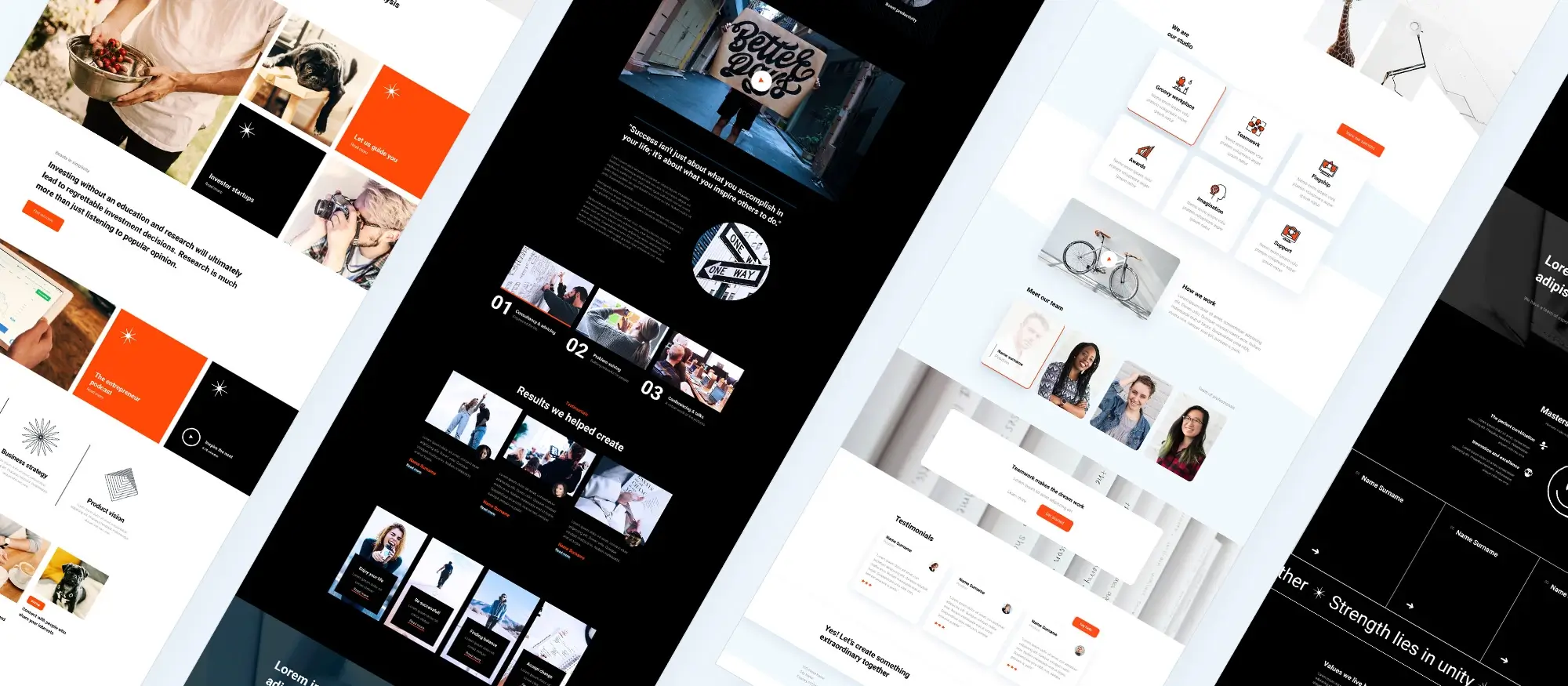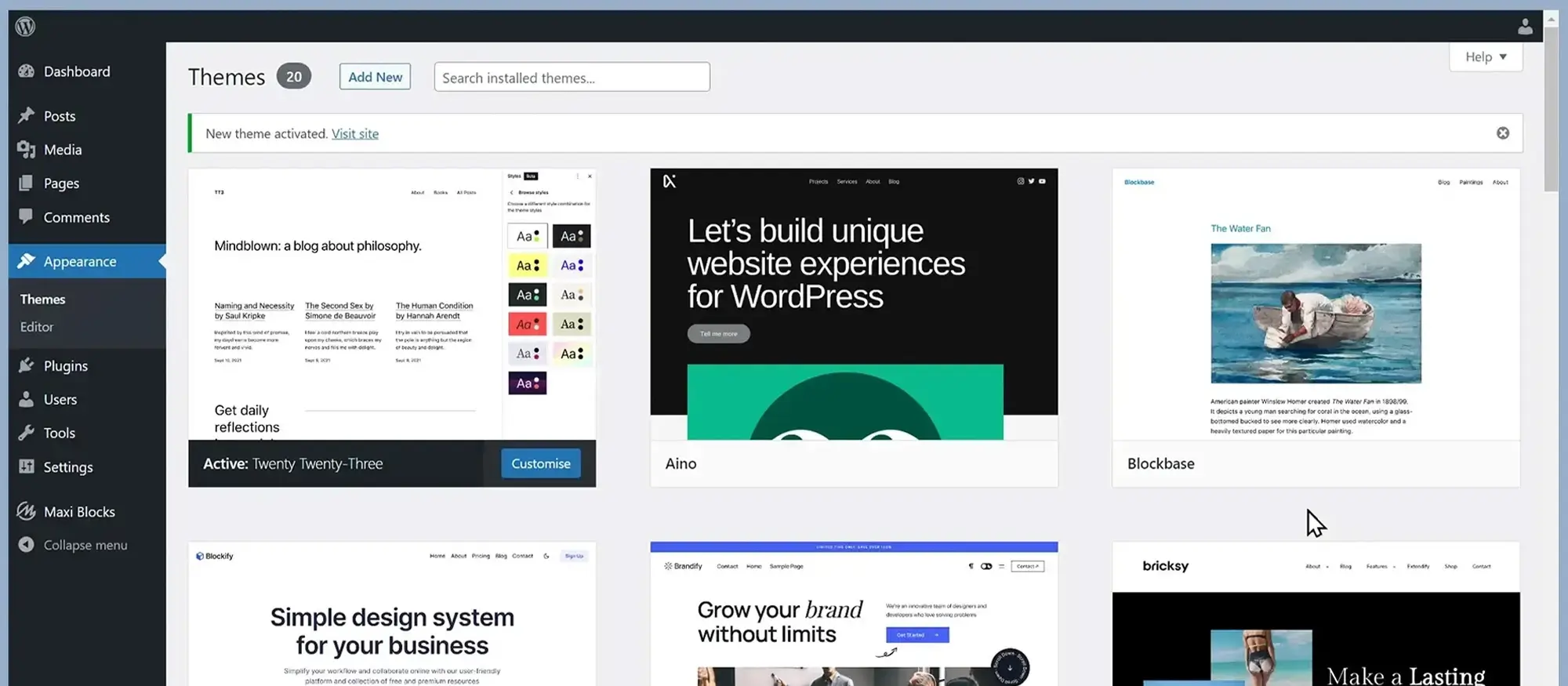20 things to consider with WordPress tutorials
Try MaxiBlocks for free with 500+ library assets including basic templates. No account required. Free WordPress page builder, theme and updates included.

Updated 15th May 2025
Getting started with WordPress tutorials
Creating an effective WordPress tutorial begins long before you write your first line or press record. It requires careful planning, a strong understanding of your audience, and a clear focus on delivering value.
Identifying your audience
Understanding who your tutorial is for is the first and most important step. Are you speaking to beginners who’ve never used WordPress before, or are you targeting users with some experience who want to improve their skills? Advanced users may be looking for more technical guidance, such as plugin development or performance optimisation.
The language, pacing, and level of detail in your tutorial should match the audience’s experience. A beginner will need clear, step-by-step guidance and explanations of basic terms, while more experienced users will appreciate depth, efficiency, and actionable insights.
Choosing the right topic
Selecting a strong topic is just as critical. Think about the common challenges WordPress users face, or explore what’s currently trending in the WordPress community. Your topic should aim to solve a problem, answer a frequently asked question, or explore a new feature in a way that’s practical and engaging.
It helps to monitor forums, WordPress blogs, and social media to see what people are struggling with or curious about. Whether you’re covering basic theme setup, building a custom plugin, or diving into Full Site Editing, the goal is to create content that feels timely, relevant, and genuinely useful to your target audience.

Formatting and structuring your WordPress tutorials
Once you’ve defined your audience and chosen a relevant topic, the next step is to think about how you present your tutorial. A well-organised and clearly structured tutorial is easier to follow, more engaging, and far more likely to be shared and recommended.
Selecting the right tutorial format
The format you choose depends on both the subject matter and your intended audience. Written tutorials are excellent for providing detailed, step-by-step instructions that users can refer back to at any time. They work especially well for SEO and can be easily updated as WordPress evolves.
Video tutorials are ideal for visually demonstrating processes. If you’re showing how to navigate the WordPress dashboard, install a plugin, or customise a theme, screen recordings can make the learning process more intuitive. For more hands-on learning, live workshops or webinars can help users interact, ask questions, and get direct feedback as they follow along.
Choosing the most suitable format helps ensure your message is received in the clearest, most effective way.
Planning a logical structure
Every good tutorial has a clear structure. Start with a brief introduction to explain what the tutorial will cover and what the audience can expect to learn. Break the tutorial down into sections that follow a logical progression, moving from foundational concepts to more detailed steps.
This structure allows readers or viewers to build their understanding gradually and makes it easier for them to revisit specific parts later.
Giving clear, step-by-step guidance
When you’re explaining how to complete a task in WordPress, aim to guide your audience through each step in a simple, actionable way. Explain what needs to be done, where to click, what to select, and why each step matters.
Supporting your instructions with screenshots or screen recordings can make a huge difference, especially for visual learners. Clear visuals help eliminate confusion and give users the confidence to follow your guidance correctly.
Emphasising key points and common mistakes
Not every part of a tutorial carries equal weight, so it’s helpful to highlight essential information or warnings. If there’s a common mistake to avoid or a setting that often gets overlooked, draw attention to it with bold text or callouts.
For written tutorials, it’s useful to use spacing and formatting techniques to separate key notes from the main instructions. Even without bullet points or numbered lists, strong paragraph structure and clear signposting can make your content easier to scan and absorb.
Subscribe to our newsletter
Adding value to your WordPress tutorials
A great tutorial goes beyond simply explaining a process. To truly stand out and serve your audience, your content should be practical, helpful, current, and accessible. By focusing on real-world applications and user experience, you’ll deliver far more value and build long-term trust with your readers or viewers.
Using practical examples to boost understanding
Theory is useful, but practical application helps your audience connect the dots. Including real-life examples or mini case studies can make abstract concepts feel more tangible. If you’re showing how to build a landing page, for instance, walk through a complete example with a fictional business or real-world use case. When people can visualise how the instructions apply to their own websites, they’re more likely to remember and apply what they’ve learned.
Offering troubleshooting advice
Even the clearest tutorials can’t prevent every issue, which is why it’s wise to include a section dedicated to troubleshooting. Anticipate common mistakes or confusion points and offer straightforward solutions. Whether it’s a missing menu item, a plugin conflict, or a styling issue, providing helpful fixes will save your users time and reduce frustration. Including a brief FAQ at the end can also help address follow-up questions without overwhelming the main content.
Keeping your tutorials up to date
The WordPress ecosystem changes quickly, with frequent updates to the core platform, themes, and plugins. What works today might look different in a few months. Regularly reviewing and updating your tutorials ensures your content stays relevant and trustworthy. Add version notes if a tutorial has been revised, or highlight when a feature has changed since the tutorial was first published. Up-to-date content ranks better and reflects well on your reliability as a creator.
Making your tutorials accessible to everyone
Accessibility isn’t just about screen readers it’s also about clarity. Use plain language and avoid overly technical terms where possible. If you need to use specific WordPress terminology, take a moment to explain it for newcomers. Short paragraphs, clear headings, and a consistent tone all help make your tutorials easier to follow for users of all levels.
Consider adding captions to your videos and writing alt text for images in written guides. These small steps make a big difference for those who learn differently or are using assistive technology.

Interaction and engagement in your WordPress tutorials
Creating a great tutorial is only half the story how you interact with your audience and promote your content can make all the difference. Encouraging engagement helps build a community around your work, while strategic promotion ensures your tutorials reach the right people.
Encouraging reader interaction
Inviting questions and feedback can transform a tutorial from a one-way explanation into a meaningful dialogue. Make sure your audience knows they’re welcome to leave comments or reach out if something isn’t clear. Responding to questions not only supports your readers but also adds value to your content by clarifying points for others who might have similar concerns.
Interactive features like comments, contact forms, or even short quizzes at the end of your tutorial can increase participation and help you better understand what your audience finds helpful or confusing.
Promoting your tutorial effectively
Even the most detailed tutorial needs visibility. Share your tutorial across your social media channels, especially in WordPress-focused communities where your content is likely to resonate. Forums, Facebook groups, and subreddits dedicated to WordPress are ideal spaces for reaching interested users.
Collaborating with other creators or influencers in the WordPress space can also amplify your reach. Consider guest posting, cross-promotions, or being featured in a newsletter to get your content in front of a wider, but still relevant, audience.
Measuring tutorial effectiveness
Once your tutorial is live and being shared, take time to review how it performs. Look at engagement metrics such as page views, average watch time for videos, comment activity, and bounce rates. These indicators reveal how useful your content is and whether your audience is staying engaged.
Direct feedback is also valuable. Encourage readers to let you know what they found helpful or what they’d like to see improved. This insight allows you to refine your future tutorials and continually improve the quality and clarity of your content.
Build like a pro
Enhancing the learning experience in your WordPress tutorials
To make your tutorials as useful and engaging as possible, it’s important to look beyond the core content. Great design, thoughtful structure, and supporting resources all work together to improve understanding and user satisfaction. These finishing touches can turn a good tutorial into a truly valuable learning tool.
Providing additional resources
One of the most helpful things you can do for your audience is to guide them toward further learning. Linking to related tutorials, WordPress documentation, or relevant blog posts allows readers to dive deeper into the topic at their own pace. Recommending plugins, tools, or themes especially those that complement the subject can also add practical value and make it easier for users to implement what they’ve just learned.
By extending the journey, you keep your readers engaged and position yourself as a helpful, trusted resource.
Applying SEO best practices
Even the most detailed tutorial won’t help anyone if it can’t be found. Optimising your content for search engines ensures it reaches the right audience. Focus on using relevant keywords naturally within your headings and body content. Write clear, descriptive titles and meta descriptions that tell both search engines and readers exactly what your tutorial covers.
Using image alt text, structuring content with heading tags, and linking to related posts all help improve your tutorial’s visibility and performance in search results.
Designing for readability
Presentation matters. Choosing clean, legible fonts and using a layout that flows well across devices will help keep your audience engaged from start to finish. Keep paragraphs short, break up text with headings and visuals, and ensure there’s enough contrast between text and background for easy reading.
A well-designed tutorial feels approachable and trustworthy, encouraging users to stick with it and return for more.
Testing your content before publishing
Before you make your tutorial public, take time to follow your own instructions step by step. This helps ensure that everything is accurate, complete, and easy to follow. It can also reveal small details you may have overlooked during the writing process.
If possible, ask someone else preferably someone from your target audience to try it out and give feedback. A fresh perspective can quickly uncover any areas that need clarification or adjustment, making your final version even stronger.

Final touches and ethical considerations for your WordPress tutorial
Once your tutorial is complete, it’s worth taking a moment to refine how you close it out. A strong conclusion, ethical integrity, and post-publication engagement all contribute to the value your content brings not just in the moment, but long term.
Including a helpful summary
Conclude your tutorial by briefly summarising the key points covered. This recap helps reinforce what your audience has learned and makes the overall message easier to remember. It’s also a good opportunity to suggest a next step, whether it’s a related tutorial, a deeper topic to explore, or a tool that complements what they’ve just learned.
Summaries act as a mental signpost, helping users feel like they’ve achieved something and encouraging them to keep going.
Addressing legal and ethical responsibilities
Always ensure your content respects copyright laws and gives appropriate credit to third-party assets or sources. If you’ve used someone else’s code, design elements, or quotes, be sure to attribute them clearly. Not only does this demonstrate professionalism, but it also helps you build trust with your audience.
Ethical transparency is especially important when recommending tools or services let readers know if you’re affiliated with a product, and be honest about your experiences with it.
Engaging after the tutorial is published
Publishing a tutorial doesn’t mean the work is finished. Staying connected with your readers adds long-term value to your content. Responding to comments, sharing extra tips on social media, or updating the tutorial to reflect recent WordPress changes shows that you care about your audience’s success.
Ongoing engagement builds loyalty and positions you as a helpful, approachable expert in your space.
Try MaxiBlocks: A powerful, beginner-friendly WordPress builder
If you’re ready to turn what you’ve learned into action, MaxiBlocks is a fast, flexible, and completely free WordPress page builder that’s perfect for building tutorials or real-world sites alike. It comes with over 500 design assets, including basic templates, and doesn’t require an account to get started.
Pair it with the MaxiBlocks Go theme for a streamlined, fully customisable WordPress experience ideal for anyone creating content, experimenting with layouts, or learning web design.
Start building today and see just how easy it is to create clean, professional-looking pages with no code required.
Getting started with WordPress
Whether you’re brand new to website building or simply exploring your options, getting started with WordPress can feel overwhelming. These FAQs will help you take the first confident steps.
What is WordPress and why is it so popular?
WordPress is an open-source content management system that powers over 40% of websites online. If you’re curious about what makes it so widely used, this overview of WordPress explains it clearly.
What’s the difference between WordPress.com and WordPress.org?
The key difference is control, WordPress.org gives you full freedom to customise and host your own site, while WordPress.com handles hosting but with limitations. This guide for beginners breaks it down simply.
How do I install WordPress?
Installing WordPress is easier than you might think. Most hosts offer one-click installation, and this beginner’s guide walks you through the process step by step.
What is a WordPress website exactly?
A WordPress website is any site built on the WordPress platform, whether it’s a blog, a shop, or a full business site. Here’s a helpful explanation for those completely new to it.
How do I choose a domain for my WordPress site?
Your domain name is your site’s digital address, and choosing one wisely is crucial. This guide to selecting a domain can help you avoid common mistakes.
Where should I begin if I’ve never built a website before?
Start with this beginner’s guide to WordPress or this introduction for aspiring developers both are written with newcomers in mind.
Is there a checklist for getting set up on WordPress?
Yes! For a structured start, this setup guide is perfect. It covers everything from hosting to going live.
Why is WordPress still the top choice in 2025?
With its flexibility, massive plugin ecosystem, and global community, WordPress remains unmatched. This article explains why WordPress is still a top choice for businesses and creatives alike.
Building and designing a WordPress website
Ready to move from idea to reality? Whether you’re creating a blog or an online store, these FAQs focus on building and designing your WordPress website the right way.
How do I design a professional-looking WordPress site?
Good design starts with choosing the right theme and layout. This guide on how to design a WordPress website explains the process clearly, even if you’re not a designer.
What’s the best way to get started with WordPress site design?
If you’re looking for a practical introduction, this getting started guide walks you through the basic tools and strategies you’ll need.
Can I build a website on WordPress myself?
Absolutely. This how-to on building a WordPress website is ideal if you’re going the DIY route. It’s easier than ever with today’s tools.
What are the different ways to build a WordPress website?
Whether you prefer tutorials or visual builders, there’s no shortage of methods. Here’s a practical overview of how to build a WordPress website using various approaches.
Is there a fast way to create a website using WordPress?
Yes—this guide to building a site with WordPress shows how to do it efficiently without cutting corners.
Can beginners really make a WordPress website?
Definitely. If you’re just starting out, this beginner-friendly tutorial offers a straightforward path from idea to launch.
What steps should I follow when launching a new WordPress site?
This detailed guide on how to start a WordPress website lays out the launch process in clear, manageable steps.
What if I want something more custom or advanced?
Then you’ll want to explore WordPress website development, which dives deeper into custom coding, integrations, and performance optimisation.
WordPress customisation, features & tutorials
Once your site is live, the fun begins, customising your theme, enhancing features, and learning how to get the most out of WordPress. These FAQs will help you go further.
How can I customise my WordPress theme?
From changing colours to editing layouts, this theme customisation guide gives you full control over your site’s look and feel.
Where can I find useful WordPress tutorials?
The WordPress tutorials section on Maxiblocks is a treasure trove of step-by-step guides, whether you’re a beginner or advanced user.
What is Gutenberg and how do I use it?
Gutenberg is WordPress’s block editor a visual way to build pages without code. Learn more in this Gutenberg tutorial or explore the Gutenberg wiki for advanced details.
What if something goes wrong with my site?
Don’t worry—most issues can be fixed. This guide to debugging and troubleshooting WordPress walks you through common fixes.
What kinds of sites can I build with WordPress?
The possibilities are endless. These fun WordPress website ideas showcase creative and unique use cases to inspire you.
WordPress costs and value
Before you dive in, it’s worth understanding the cost side of WordPress. These FAQs cover everything from pricing to long-term value.
How much does it cost to design a WordPress site?
It depends on your needs, but this cost breakdown outlines typical ranges for themes, plugins, and services.
What’s the average budget for a full WordPress site?
For a broader perspective, this article on WordPress design costs explains what to expect if you’re planning a professional site.
What are the ongoing costs of running a WordPress website?
Aside from the initial build, you’ll need to consider hosting, maintenance, and occasional plugin costs. This cost guide offers a full breakdown.
Is WordPress worth the investment?
If you value flexibility, ownership, and long-term scalability, then yes. This guide to the benefits of WordPress shows why it’s still a strong choice for all kinds of users.
WordPress popularity and reputation
With so many platforms available, you may wonder whether WordPress still holds up. These FAQs explore its relevance and success in 2025 and beyond.
Which major brands use WordPress?
Plenty! From The New Yorker to BBC America, these famous WordPress sites show the platform is trusted by big names.
Is WordPress still widely used today?
Yes, millions of websites are still powered by it. If you’re questioning its future, this article on WordPress usage will reassure you it’s far from obsolete.
Explore how to create a powerful WordPress website
Learn how to design, build, and optimize your WordPress website from start to finish.
FAQs – Comprehensive WordPress tutorials for beginners
How do I decide what topic to cover in a WordPress tutorial?
Start by thinking about your target audience. Consider their experience level and what problems or questions they’re likely to have. Popular topics often include how to install WordPress, set up a theme, use page builders, or troubleshoot common errors. Look at online forums, social media groups, or your own website’s search data to find recurring challenges you can help solve.
Should I create written or video tutorials?
It depends on your audience and the complexity of the topic. Video is great for visually demonstrating tasks, especially when showing users where to click or how to navigate WordPress. Written tutorials, on the other hand, are better for in-depth explanations, step-by-step guides, and SEO. If you can, offering both can help you reach a wider audience.
How can I make my tutorial easy to follow?
Break the content into clear sections and explain each step in a logical order. Avoid technical jargon unless you explain it, and use plain language where possible. Adding screenshots, video clips, or screen recordings can help clarify your points and give users something visual to follow.
What should I include in a WordPress tutorial?
A good tutorial typically starts with an introduction that explains what users will learn. Then it walks through the steps clearly, highlighting any common mistakes or tips along the way. A conclusion that summarises the key points and suggests what to do next is also useful. Optional sections like FAQs, downloadable checklists, or links to further resources can add even more value.
How do I make sure my tutorial stays up to date?
WordPress evolves regularly, so make a habit of reviewing your tutorials every few months. Check for outdated screenshots, interface changes, or deprecated plugins and update your content accordingly. Adding a “last updated” note can also help reassure your audience that the tutorial is still relevant.
Can I include product or plugin recommendations?
Absolutely, but be transparent about any affiliations. Only recommend tools or plugins you’ve used and genuinely believe will benefit your readers. Including clear links, honest feedback, and practical examples of how the product works will make your recommendations more helpful and trustworthy.
How can I track whether my tutorial is effective?
Engagement is a strong indicator look at page views, time spent on the page, comment activity, and whether users follow through on calls to action. Ask for feedback directly, or check if your tutorial is being shared or bookmarked. These signs suggest your content is useful and worth improving over time.
WordPress itself
Official Website
wordpress.org – This is the official website for WordPress, where you can download the software, find documentation, and learn more about using it.
WordPress Codex
codex.wordpress.org/Main_Page – This is a comprehensive documentation resource for WordPress, covering everything from installation and configuration to specific functionality and troubleshooting.
WordPress Theme Directory
wordpress.org/themes – The official WordPress theme directory is a great place to find free and premium WordPress themes. You can browse themes by category, feature, and popularity.
maxiblocks.com/go/help-desk
maxiblocks.com/pro-library
www.youtube.com/@maxiblocks
twitter.com/maxiblocks
linkedin.com/company/maxi-blocks
github.com/orgs/maxi-blocks
wordpress.org/plugins/maxi-blocks

Kyra Pieterse
Author
Kyra is the co-founder and creative lead of MaxiBlocks, an open-source page builder for WordPress Gutenberg.
You may also like
